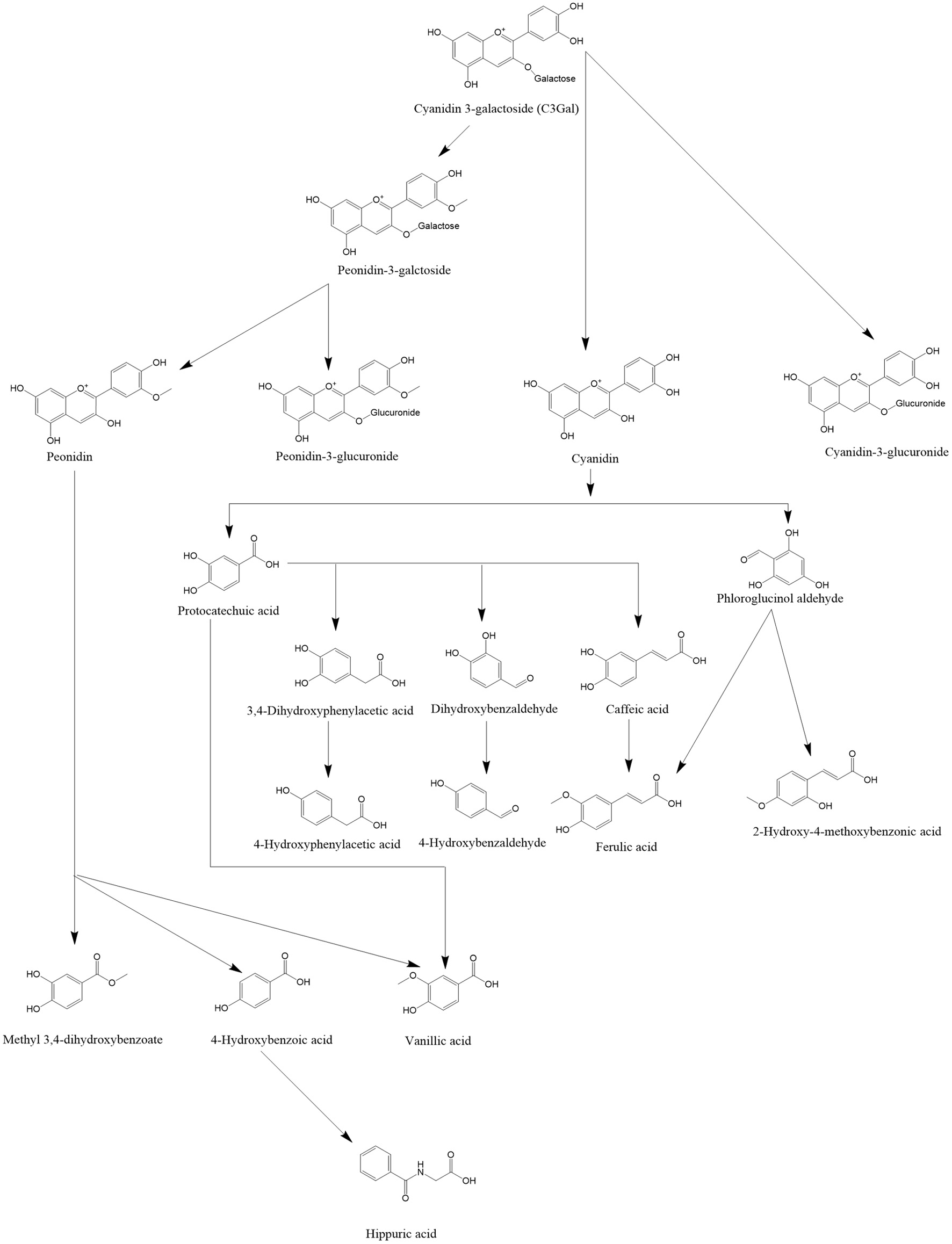| vascular health | spontaneously hypertensive rats | freeze-dried aronia berry in diet (10%), 25 days | blood pressure ↓, WG ↓, ACE activity in kidney ↓ | Yamane et al., 2017 |
| L-NAME-induced hypertensive rats | aronia extract (57.90 mg/kg/day), 21 days | BW ↓, heart weight ↓, TNF-α ↓, IL-6 ↓, conjugated dienes ↓, nitric oxide synthase ↑, | Cebova et al., 2017 |
| coronary artery endothelial cells | aronia extract (0.0001 – 100 mg/mL) | nitric oxide synthesis ↑, endothelial nitric oxide synthase activation ↑ | Varela et al., 2015 |
| brain health | adult rats | aronia juice (ad libitum), 30 days | anxiety like behaviors ↓ | Tomić et al., 2016 |
| rat skeletal muscle cells, primary neuronal cells from prenatal rats, mice for in vivo MRI study | aonia berry extract in diet (50 mg/kg), applied to cells | skeletal muscle cells (hydrogen peroxide ↓) neuronal cells (inflammatory markers ↓) in vivo (BNDF↑) | Kim et al., 2019 |
| BV2 cells | ethanolic aronia extract (0.03 – 2 mg/mL) | nitric oxide ↓, COX-2 ↓, IL-6 ↓, TNF-α ↓ | Lee et al., 2018 |
| LPS-induced neural inflammation in mice | ethanolic aronia extract (50 mg/kg/day), 7 days | hippocampal damage ↓, neuroinflammaton ↓ |
| HT22 mouse hippocampal cells | aronia extract (10, 100 μg/mL); cyanidin-3-O-galactoside (1 or 10 μg/mL) | ROS ↓, intracellular calcium levels ↓, glutamate activity ↓ | H. Y. Lee et al., 2017 |
| aged rats (24 mo.) | aronia juice (10 mL/kg, diluted 1:1 with water), 105 days | dentate gyrus ↔, density of nerve fibers ↑, acetylcholinesterase activity ↑ | Daskalova et al., 2019 |
| scopolamine-induced memory impaired mice | aronia extract (200, 400 mg/kg); cyanidin-3-O-galactoside (50 mg/kg) | memory ↑, acetylcholinesterase ↓, brain-derived neurotropic factor ↑, cAMP-response element binding protein ↑ | H. Y. Lee et al., 2016 |
| metabolic function | diabetic KK-Ay mice | aronia juice (ad libitum), 28 days | BW ↓, blood glucose ↓, white adipose tissue ↓, DPP IV activity ↑, glucosidase activity in upper small intestine ↓, | Yamane et al., 2016 |
| high-sucrose, high-fat fed mice | aronia juice concentrate (1.44 g/kg diet), 12 weeks | High-sucrose diets: BW ↓, glucose ↑, insulin ↓, triglycerides ↓, adiponectin ↑, HOMA-IR ↑, HOMA-BCF ↑, FAS ↓, PPARY ↑; High-fat diets: BW ↓, glucose ↓, insulin ↓, triglycerides ↓, adiponectin ↑, HOMA-IR ↑, HOMA-BCF ↑, FAS ↓, PPARY ↑ | Baum et al., 2016 |
| high-carbohydrate, high-fat fed rats | aronia juice (50 mg/kg diet), 8 weeks | adiposity index ↓, total body mass ↓, systolic blood pressure ↓, glucose tolerance ↑, liver function ↑, cardiovascular function ↑, inflammatory in heart/ liver ↓ | Bhaswant et al., 2017 |
| high-fructose, high-fat diet-induced dyslipidemic mice | aronia powder (1% in diet), 10 weeks | WG ↓, central obesity ↓, liver weight ↓, epididymal fat ↓, triglycerides ↓, cholesterol ↓, LDL ↓, insulin resistance ↑ | Jeong and Kim, 2019 |
| high-fat fed mice | lyophilized aronia powder (10% in diet), 28 days | liver weight ↔, total lipid level ↓, cholesterol ↓, triglycerides ↓, LDL ↓, mild fibrosis ↓, FABP1 ↓, FABP4 ↓ | Yamane, Kozuka, Yamamoto, et al., 2016 |
| cancer prevention | human liver cancer SK-Hep1 cells | aronia extract (0–200 μg/mL) | growth of cancer cells ↓, cell adhesion ↓, wound healing migration ↑, MMP-2/9 expression↓ | Thi and Hwang, 2018 |
| human breast cancer cell lines MCF-7 and MDA-MB-231 | catechol isolated from fermented aronia juice | proliferation formation ↓, mammosphere formation ↓, ALDH-expressing cell ↓, self-renewal-related genes ↓, mRNA transcripts , protein levels ↓ | Choi et al., 2018 |
| anti-bacterial | foodborne pathogens and spoilage organisms | ethanol extracts of aronia berry | Gram-positive: B. cereus ↓, B. pumilus ↓, K. rhizophila ↓, L. monocytogenes ↓; Gram-negative: C. jejuni↓, S. Enteritidis ↓, E. coli ↓ | Raudsepp et al., 2019 |
| foodborne pathogens | ethanol extract of aronia berry | Gram-positive: B. cereus ↓, S. aureus ↔ Gram-negative: S. entritidis ↔, C. sakazakii ↔ | D.-H. Kim et al., 2018 |
| colitis prevention | mice injected with syngeneic CD4+CD62L+ naïve T cells | lyophilized aronia berry (4.5% in diet), 7 weeks | colonic Treg ↑, IL-17A+IL-10+ ↑and IL-17A+IL-22+ ↑, CD4+ cells ↓, Verrucomicrobia ↓; Bacteroidetes ↑, Firmicutes ↑, Proteobacteria , colonic weight/length ratio ↓ | Pei et al., 2018 |
| male Wistar rats with TNBS-induced colitis | aronia fruit juice (2.5, 5, and 10 mL/kg, 14 days | TNBS, colon shortening, colone weight ↑, inhibited colonic weight/length ratio , lesion extension ↓, adhesion score ↓, wall thickening ↓ | Valcheva-Kuzmanova et al., 2018 |
| Human umbilical vein endothelial cells stimulated with (TNF-α) | aronia berry extract | TNF-α-induced moncyte/endothelia adhesion ↓, VCAM-1 ↓, ICAM-1 ↔, STAT3 ↓ IRF1 ↓, NF-κB ↔ | Iwashima et al., 2019 |
| mice injected with CD4+CD62L+ naïve T cells to induced colitis | lyophilized aronia berry (4.5% in diet), 5 weeks | colon weight/length ratio ↓, FDG uptake in spleen, liver and lungs ↓, TNF-α ↓, IFN-γ ↓, prevention of rGSH from ↓, GPx,activity ↔, splenic mitochondrial H2O2 ↓ | Pei et al., 2019 |
| Caco-2 cells with IC | whole Aronia berry powder (0.5–10 mg/mL) | Inhibited loss of TEER, prevented IC- induced barrier permeability, inhibited CLDN1, ZO-1 ↓ | Valdez et al., 2020 |
